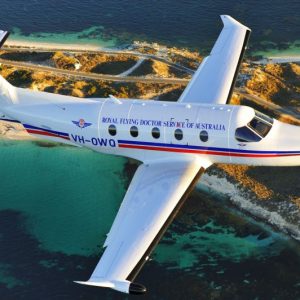
Australia’s Royal Flying Doctor Service (RFDS) is renown around the world, but why is it so famous and what exactly does the RFDS do?
Australia is a vast country. For people living and working in rural and remote areas, medical assistance is often hundreds of kilometres away.
The RFDS was established in the state of Queensland in 1928 largely due to the efforts of Reverend Dr John Flynn, whose work involved setting up hostels and bush hospitals for miners, road and rail workers, and other settlers.
The service, initially known as the Aerial Medical Service, grew rapidly and became nationally available within two years.
The Royal Flying Doctor Service now consists of a fleet of 66 aircraft, 23 aero-bases and 48 road patient vehicles, and supports an area covering 7.3 million square kilometres. The majority of the RFDS aircraft have been modified to carry medical equipment and some vehicles have been customised for specific purposes, for example dental care or eye care.
The service is constantly changing as it strives for excellence and to meet the needs of the community, and the role of the RFDS now extends beyond patient transport. 24-hour emergency aeromedical retrieval is still available to patients with a life-threatening illness or accident victims but the majority of the work done today by the RFDS is delivering primary healthcare, which includes running health clinics to allow people to access specialists such as dentists and mental health professionals.
Typically one pilot and one nurse staff the majority of RFDS flights but for seriously or critically ill patients – around 20% of cases – a doctor will assist.
The Royal Flying Doctor Service employs over 1200 staff including registered nurses, medical practitioners, dentists and support staff.
Professionals are attracted to an RFDS job for a variety of reasons, some of them are wanting a lifestyle change and the challenge of working in small communities, as well as the opportunity to work for such a well-respected organisation.
RFDS jobs might involve anything from flying through a storm to transfer a seriously unwell newborn to a Neonatal Intensive Care Unit, to transporting a patient recovering from spinal surgery back home, to conducting a GP outreach clinic.
RFDS staff may also provide advice over the telephone or radio, referred to as tele-health consultations, and patient callers are able to access standard medicines and first aid equipment through 3000 medical chests situated in isolated and remote areas around Australia on medical advice.
The Royal Flying Doctor Service is funded largely by the Commonwealth, State and Territory governments but also relies on donations. The RFDS is a registered charity, regulated by the Australian Charities and Not-for-profit Commission, and is consistently voted Australia’s most reputable charity.
Working in remote Australia, can give you exposure to the RFDS, and you may work in close contact with the service. If you’re interested in a rewarding and challenging career, then you may want to think about working as a doctor or GP in aboriginal health services.
